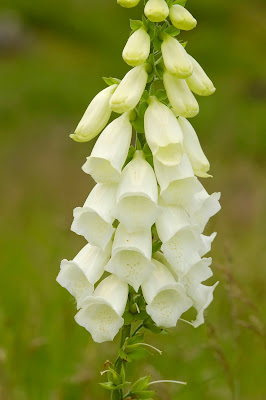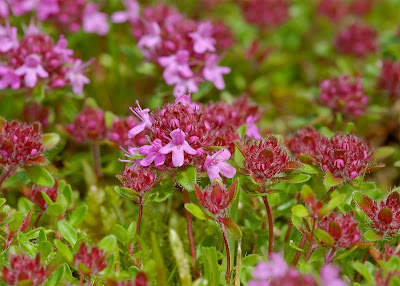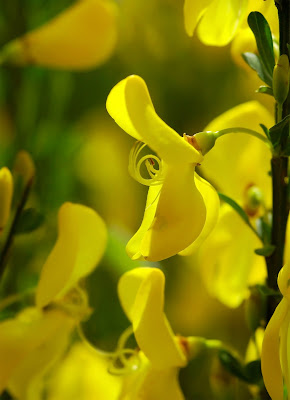I found a dead Stoat at the bottom of Beeches Road, close to the collapsed WW2 bomb shelter (now a pile of concrete slabs).
As I crossed the sheep field above Haw Craig, a Brown Hare started up from under my feet - a magnificently large individual.
Sitting on the cliff overlooking Haw Craig, I heard harsh chattering and caught a brief flash of colour as a Jay swiftly glided from one tree to another. They had good reason to be nervous: I soon spotted the steely-grey back of a male Sparrowhawk slipping stealthily between the Hawthorn scrub.
Tall spikes of magenta Foxgloves filled the valley and Hairy Thyme furnished the tops of boulders and loose scree with pink.
Foxglove (Digitalis purpurea)
Foxglove (Digitalis purpurea)
Foxglove (Digitalis purpurea) white mutation
Foxglove (Digitalis purpurea) white mutation
Foxglove (Digitalis purpurea) colour variations
Foxglove's scientific name means 'Of-the-fingers purple' in Latin (Digitalis = of the fingers & purpurea = purple) referring to the way in which the flowers can be fitted thimble-like onto the fingertips.
Amongst the foxgloves I found this toothless old fox skull:
Fox skull (Vulpes vulpes)
Flat or concave post-orbital processes (the projections at the upper rear of the eye socket) indicate that this is a fox's skull.
In dogs, the post-orbital processes are convex and elevated above the muzzle (forming a distinct stop between forehead and base of nose).
An excellent guide to skull identification can be found here: http://www.btinternet.com/~alison.gilsland/hedbone/lists.htm.
Hairy Thyme (Thymus praecox)
Hairy Thyme (Thymus praecox)
This species can be used in recipes in exactly the same way as cultivated varieties, though the flavour is weaker. Thyme also has medicinal properties: it contains thymol (aka 2-isopropyl-5-methylphenol) which is strongly antiseptic and antimicrobial.
Orchid Beetles (Dascillus cervinus) were present in large numbers on the patches of thyme.
Broom (Cytisus scoparius)
Wood Avens (Geum urbanum)
Wood Avens Recipes:
Wood Avens & Dandelion Coffee (from www.bbc.co.uk)
Woodland Spiced Rosehip and Beetroot Soup (from www.bbc.co.uk)
Fried Wood Avens Leaves (from www.eatweeds.co.uk)
Common Blue Damselflies (Enallagma cyathigerum) are beginning to emerge where the river runs through Haw Craig.
The Triangle Reservoir was rather quiet: I saw only 1 Sand Martin.
On the stony banks of the reservoir I nearly managed to catch a vole. Then I somehow managed to fall INTO the Triangle Reservoir (oops!) whilst observing the thick black mass of tadpoles congregated at the bottom.
On my return home I found this guy:
Poplar Hawkmoth (Laothoe populi) male
Poplar Hawkmoth (Laothoe populi) male
Poplar Hawkmoth (Laothoe populi) male
Poplar Hawkmoth (Laothoe populi) male - wing detail
Poplar Hawkmoth (Laothoe populi) male
Poplar Hawkmoth (Laothoe populi) male
Poplar Hawkmoth (Laothoe populi) male
Common, but still an impressive moth: about 5cm in length from wing to wing! This species lacks a functional proboscis and therefore cannot feed during adulthood.
Poplar Hawkmoths can be sexed easily: males have narrow, blunt-tipped abdomens while females have pointed abdomens.






















What a marvelous walk with such intriguing finds.
ReplyDeleteYour photography is superb. I go up Kilpatrick hills often but i must do so with my eyes closed.I will see it in a new light when I go back up this week, thank you for opening my eyes to the wonderful wildlife here.
ReplyDeleteThanks! :)
ReplyDeletejayvee 30 June 2014
ReplyDeleteJust found one of these this morning in the house. Your photos were very helpful confirming! She is outside now waiting for sunset.